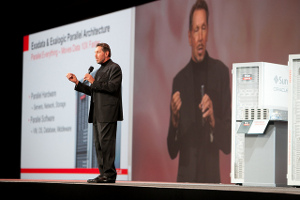Oracle unveils Exalytics in-memory analytics machine

Larry Ellison announces business intelligence system at OpenWorld...

Larry Ellison announces Oracle's latest system-in-a-box, Exalytics, at the OpenWorld event in San FranciscoPhoto: Oracle PR
Oracle today revealed the next addition to its engineered systems line with the launch of its Exalytics analytics system.
Exalytics joins Exadata, Exalogic and Database Appliance in Oracle's line-up of hardware-plus-software appliances.
According to Oracle CEO Larry Ellison, Exalytics can cope with relational, unstructured and multidimensional data. It's powered by 40 Intel Xeon cores and has 1TB of main memory - or the equivalent of 5TB or more once compressed.
Exalytics makes use of Oracle BI Foundation Suite along with in-memory analytics tech that hails from Oracle's acquisition of TimesTen, which it bought back in 2005. "Databases run faster - everything runs faster - if you keep it in DRAM, if you keep it in memory," Ellison said.
The machine makes use of a heuristic adaptive in-memory cache, or, as Ellison puts it, "if people are asking the same question over and over again, we keep it in memory".
"A human being can override adaptive cache - human beings can come and tune this but it will tune itself. This thing is constantly learning by watching what users are doing and moving it into memory," he added.
Exalytics is in competition with the likes of IBM's Netazza and EMC's Greenplum offerings. SAP has also been a cheerleader for in-memory analytics, having, like Oracle, released an analytics appliance that makes use of it.
Unlike Oracle, however, SAP's offering - called Hana - has all data sit within the application memory, rather than the DRAM - a move that could oust the database entirely, according to Scott Tiazkun, senior consultant at analyst house PAC.
"From a strategic perspective, what SAP may also achieve is building Hana to be an in-memory data architecture for all its applications, effectively negating the traditional database one day. In other words, SAP will try to cut Oracle out of its technology stack with Hana, and based on the technology and technology roadmap, it is quite possible SAP could achieve this," he wrote in a blog post.